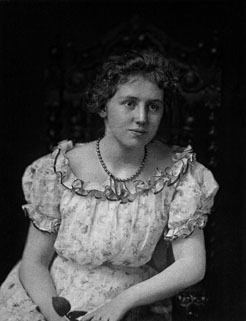Name Alyse Gregory | Role Writer | |
 | ||
Books King Log and Lady Lea, Hester Craddock, The Cry of a Gull: Journals, 1923-1948 | ||
Llewelyn Powys - memorial stone.AVI
Alyse Gregory (July 19, 1884 Norwalk, Connecticut, United States – August 27, 1967 Morebath, Devon, England) was an American suffragist and writer.
Her father, James G. Gregory, was a doctor in Norwalk. She showed musical talent at an early age, was sent to Paris, France to receive a musical education when she was fifteen years old, and continued her study of music upon her return to the United States. She was invited by famous concert singer Mrs. Catherine Fiske to return to Paris, live with her, and be trained as a professional singer. She remained in Paris with Mrs Fiske for a year.
She was drawn gradually into public movements because of her interest in social justice. After returning to her home country, she decided to give up her singing ambitions. She became involved in local politics and the woman suffrage movement for which she was a fearless public speaker. Gregory decided to start a grassroots women's suffrage club in Connecticut, as she explains in her autobiography The Day Is Gone (page 100). The first meeting brought together herself and five other women. Gregory went on to become a key leader in the Connecticut Woman Suffrage Association through which she directed activities such as meetings, plays, and parades alongside Cromwell native Emily Miller Pierson. She later (page 104, op. cit.) worked as assistant state organizer for the New Jersey Woman Suffrage Association during a referendum on woman suffrage in 1915 and was also active for the cause in the State of New York.
After a visit to England during the 1914–18 First World War, she settled in Patchin Place in New York City, where she formed close friendships with a group of young artists and writers. She worked for two years as a copywriter in an advertising agency, which position she left in order to earn her living as a freelance writer. She began contributing articles to such publications as The Freeman, The New Republic and The Dial, becoming Managing Editor of this last journal in February, 1924. Six months later, she married the English writer Llewelyn Powys, and in June 1925, resigned her position with The Dial to accompany her husband to England, where for five years they lived in a coastguard cottage on White Nothe, one of the wildest headlands of the Dorset coast.
Her first novel, She Shall Have Music was published in 1926, followed by King Log and Lady Lea (1929) and Hester Craddock (1931), both of which were written in Dorset.
She and her husband visited Palestine in 1928, and they spent the winter of 1930 in a house in the Berkshire Hills lent to them by Edna St. Vincent Millay and Eugen Boissevain. From there, they paid a visit to the West Indies. On their return to England, Llewelyn Powys suffered a relapse from an old illness, and in the winter of 1936, they went to Switzerland, where she wrote a book of essays, Wheels on Gravel (1938).
After Llewelyn Powys' death from tuberculosis in Switzerland in December 1939, Alyse went to live in the same remote house as his sisters, Gertrude and Philippa Powys, on Chaldon Down near East Chaldon, and wrote her autobiographical reminiscences, entitled The Day Is Gone, published in New York by E. P. Dutton (1948). She was a friend of many eminent people, including Florida Scott-Maxwell (who had been a pupil of Jung), Randolph Bourne, Van Wyck Brooks, Lewis Mumford, Amy Lowell, William Rose Benet and his brother Stephen Vincent Benet, Malcolm Elwin, Theodore Dreiser, Edna St. Vincent Millay, Marianne Moore and Sylvia Townsend Warner. She tended to remain in the shadow of her late husband (whose work and reputation she did much to promote), while continuing to contribute her own articles to a variety of journals up until the late 1950s.
In 1957, Alyse Gregory moved into Velthams Cottage, Morebath, Devon, as the tenant of Mrs Rosamund Mary Rose (nee Rosamund Mary Trafford), at a rent of "one peppercorn a year (if demanded)". After the sudden death of her landlady on 12 May 1958, Velthams was bought at auction in 1960 by the writer Oliver Stonor, who had known Alyse previously; they were both present at local celebrations in East Chaldon on 7 or 8 May 1945, for the end of the Second World War in Europe, which took the form of a large bonfire near the Five Marys, a local group of prehistoric barrows. In her last years, many friends visited her, in spite of the rural isolation of Morebath, which had a railway station until 1966. Alyse had long been an advocate of voluntary euthanasia, and planned her departure from this life. She took a lethal overdose in 1967, and was cremated in Taunton, Somerset. Her last visitor was the historical novelist Rosemary Sutcliff.
Excerpts from her diaries were published in 1973 under the title The Cry of a Gull.
In 1999, Alyse Gregory: A Woman at her Window by Jacqueline Peltier was published (London, Cecil Woolf).
The Sundial Press reissued Gregory's third novel, Hester Craddock, at the end of January 2007 with a new introduction by Barbara Ozieblo.
